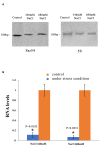A Novel sRNA in Shigella flexneri That Regulates Tolerance and Virulence Under Hyperosmotic Pressure
- PMID: 33042862
- PMCID: PMC7526569
- DOI: 10.3389/fcimb.2020.00483
A Novel sRNA in Shigella flexneri That Regulates Tolerance and Virulence Under Hyperosmotic Pressure
Abstract
Regulation of the environmental stress response and virulence of Shigella flexneri may involve multiple signaling pathways; however, these mechanisms are not well-defined. In bacteria, small regulatory RNAs (sRNAs) regulate bacterial growth, metabolism, virulence, and environmental stress response. Therefore, identifying novel functional sRNAs in S. flexneri could help elucidate pathogenic adaptations to host micro-environmental stresses and associated virulence. The aim of this study was to confirm the presence of an sRNA, Ssr54, in S. flexneri and to determine its functions and possible mechanism of action. Ssr54 was found to regulate tolerance and virulence under hyperosmotic pressure. Its expression was verified by qRT-PCR and Northern blotting, and its genomic position was confirmed by 5'-rapid amplification of cDNA ends. Ssr54 expression was significantly decreased (~ 80%) under hyperosmotic conditions (680 mM NaCl), and the survival rate of the Ssr54 deletion strain increased by 20% under these conditions. This suggested that Ssr54 has been selected to promote host survival under hyperosmotic conditions. Additionally, virulence assessment, including guinea pig Sereny test and competitive invasion assays in mouse lungs, revealed that Ssr54 deletion significantly decreased S. flexneri virulence. Two-dimensional gel analyses suggest that Ssr54 may modulate the expression of tolC, ompA, and treF genes, which may affect the virulence and survival of S. flexneri under osmotic pressures. Furthermore, treF expression has been shown to improve the survival of S. flexneri under osmotic pressures. These results suggest that Ssr54 has a broad range of action in S. flexneri response to hyperosmotic environmental stresses and in controlling its virulence to adapt to environmental stresses encountered during host infection.
Keywords: Shigella flexneri; Ssr54; environmental stress; sRNA; virulence.
Copyright © 2020 Yang, Li, Jia, Qiu, Yang, Zhu, Xie, Qiu, Li, Ma, Song and Wang.
Figures








Similar articles
-
A Novel Small RNA Regulates Tolerance and Virulence in Shigella flexneri by Responding to Acidic Environmental Changes.Front Cell Infect Microbiol. 2016 Mar 8;6:24. doi: 10.3389/fcimb.2016.00024. eCollection 2016. Front Cell Infect Microbiol. 2016. PMID: 27014636 Free PMC article.
-
hfq regulates acid tolerance and virulence by responding to acid stress in Shigella flexneri.Res Microbiol. 2015 Jul-Aug;166(6):476-85. doi: 10.1016/j.resmic.2015.06.007. Epub 2015 Jun 24. Res Microbiol. 2015. PMID: 26117597
-
Formate Promotes Shigella Intercellular Spread and Virulence Gene Expression.mBio. 2018 Sep 25;9(5):e01777-18. doi: 10.1128/mBio.01777-18. mBio. 2018. PMID: 30254126 Free PMC article.
-
Shigella flexneri: genetics of entry and intercellular dissemination in epithelial cells.Curr Top Microbiol Immunol. 1994;192:217-41. doi: 10.1007/978-3-642-78624-2_10. Curr Top Microbiol Immunol. 1994. PMID: 7859507 Review. No abstract available.
-
Ribonucleases and bacterial virulence.Microb Biotechnol. 2011 Sep;4(5):558-71. doi: 10.1111/j.1751-7915.2010.00212.x. Epub 2010 Oct 15. Microb Biotechnol. 2011. PMID: 21375713 Free PMC article. Review.
Cited by
-
Developing New Tools to Fight Human Pathogens: A Journey through the Advances in RNA Technologies.Microorganisms. 2022 Nov 21;10(11):2303. doi: 10.3390/microorganisms10112303. Microorganisms. 2022. PMID: 36422373 Free PMC article. Review.
-
Bacteroides thetaiotaomicron Outer Membrane Vesicles Modulate Virulence of Shigella flexneri.mBio. 2022 Oct 26;13(5):e0236022. doi: 10.1128/mbio.02360-22. Epub 2022 Sep 14. mBio. 2022. PMID: 36102517 Free PMC article.
-
sRNA23, a novel small RNA, regulates to the pathogenesis of Streptococcus suis serotype 2.Virulence. 2021 Dec;12(1):3045-3061. doi: 10.1080/21505594.2021.2008177. Virulence. 2021. PMID: 34882070 Free PMC article.
References
Publication types
MeSH terms
Substances
LinkOut - more resources
Full Text Sources

